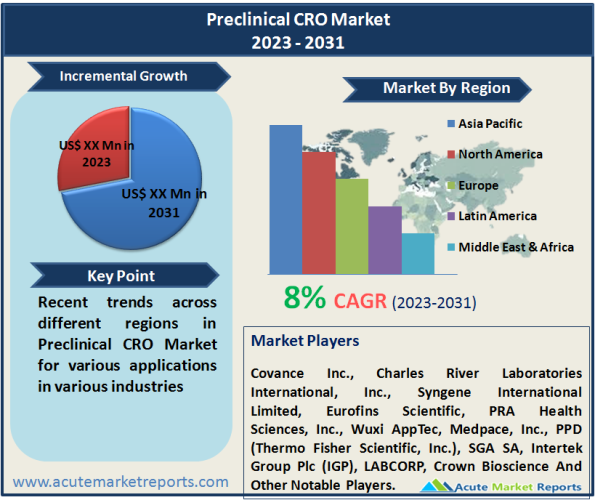
The preclinical contract research organization (CRO) market is expected to grow at a CAGR of 8% during the forecast period of 2025 to 2033. The preclinical CROs play a crucial role in supporting the pharmaceutical and life sciences industries by providing specialized research services. From 2025 to 2033, this market is expected to witness substantial growth driven by factors such as the increasing adoption of patient-derived models in preclinical research and the expanding clientele base, including biopharmaceutical companies, government and academic institutes, and medical device companies. In conclusion, the preclinical CRO market is set for substantial growth from 2025 to 2033, driven by the increasing adoption of patient-derived models in preclinical research and the expanding clientele base comprising biopharmaceutical companies, government and academic institutes, and medical device companies. While regulatory challenges pose a restraint, the market's overall outlook is promising, with specific model types, end-use segments, regions, and key players contributing to its trajectory.

Increasing Adoption of Patient-Derived Models
The rising adoption of patient-derived models in preclinical research is a significant driver of the preclinical CRO market. Patient-derived models, including Patient-Derived Organoid (PDO) Models and Patient-Derived Xenograft Models, have gained prominence due to their ability to closely mimic human physiology and disease pathology. These models are instrumental in evaluating drug efficacy, toxicity, and personalized treatment strategies. In 2024, the market witnessed a surge in demand for preclinical research services utilizing patient-derived models, reflecting the growing interest in precision medicine and tailored therapeutics. This trend is expected to continue from 2025 to 2033, with both PDO and Patient-Derived Xenograft Models playing a pivotal role in advancing drug development and disease understanding.
Expanding Clientele Base
The preclinical CRO market is experiencing growth due to an expanding clientele base. Biopharmaceutical companies, government and academic institutes, and medical device companies are increasingly relying on CRO services to accelerate their preclinical research programs. Biopharmaceutical companies, in particular, are driving demand by outsourcing a significant portion of their preclinical activities to specialized CROs. In 2024, the market benefited from this trend, with CROs catering to the diverse needs of their clients. Looking ahead to 2025 to 2033, the market is expected to witness continued growth, with Biopharmaceutical Companies as the primary end users, followed by Government and Academic Institutes and Medical Device Companies, further solidifying their reliance on CRO expertise.
Restraint - Regulatory Challenges
Despite the promising growth prospects, the preclinical CRO market faces regulatory challenges that can impede its progress. Regulatory agencies, both national and international, impose stringent guidelines and requirements on preclinical research, including the use of animal models and ethical considerations. Adhering to these regulations demands rigorous compliance and documentation, which can be time-consuming and resource-intensive. Market players must navigate this complex regulatory landscape, ensuring that their services meet the highest ethical and quality standards. Overcoming regulatory challenges is essential to maintain the trust of clients and regulatory authorities and ensure the long-term sustainability of the preclinical CRO market.
Market Segmentation by Model Type (PDO Model, Patient-Derived Xenograft Model):PDO Model Dominates the Market
The preclinical CRO market offers a range of model types to cater to the diverse needs of researchers and clients.
Market Segmentation by End-Use (Biopharmaceutical Companies, Government and Academic Institutes, Medical Device Companies):Biopharmaceutical Companies Dominate the Market
The preclinical CRO market serves a diverse clientele, each with specific research needs and objectives.
APAC to Lead the Growth during the Forecast Period
The preclinical CRO market exhibits regional variations in trends, growth rates, and revenue distribution across different geographical areas. North America is expected to maintain its position as the region with the highest revenue percentage, reflecting its strong presence of biopharmaceutical companies and research institutions. Europe and Asia-Pacific are also anticipated to experience steady growth, driven by an expanding pharmaceutical and life sciences sector. Asia-Pacific is projected to showcase the highest CAGR during the forecast period from 2025 to 2033, as the region gains prominence in the global preclinical research landscape.
Market Competition to Intensify during the Forecast Period
The preclinical CRO market is characterized by intense competition among key players, with several leading companies driving innovation and market growth. In 2024, these companies reported significant revenues, and their strategies are expected to continue shaping the market from 2025 to 2033.
Historical & Forecast Period
This study report represents analysis of each segment from 2023 to 2033 considering 2024 as the base year. Compounded Annual Growth Rate (CAGR) for each of the respective segments estimated for the forecast period of 2025 to 2033.
The current report comprises of quantitative market estimations for each micro market for every geographical region and qualitative market analysis such as micro and macro environment analysis, market trends, competitive intelligence, segment analysis, porters five force model, top winning strategies, top investment markets, emerging trends and technological analysis, case studies, strategic conclusions and recommendations and other key market insights.
Research Methodology
The complete research study was conducted in three phases, namely: secondary research, primary research, and expert panel review. key data point that enables the estimation of Preclinical CRO market are as follows:
Market forecast was performed through proprietary software that analyzes various qualitative and quantitative factors. Growth rate and CAGR were estimated through intensive secondary and primary research. Data triangulation across various data points provides accuracy across various analyzed market segments in the report. Application of both top down and bottom-up approach for validation of market estimation assures logical, methodical and mathematical consistency of the quantitative data.
| ATTRIBUTE | DETAILS |
|---|---|
| Research Period | 2023-2033 |
| Base Year | 2024 |
| Forecast Period | 2025-2033 |
| Historical Year | 2023 |
| Unit | USD Million |
| Segmentation | |
Service
| |
Model Type
| |
End-Use
| |
|
Region Segment (2023-2033; US$ Million)
|
Key questions answered in this report